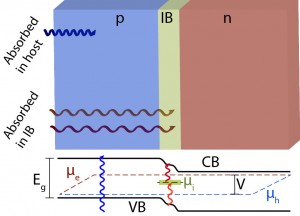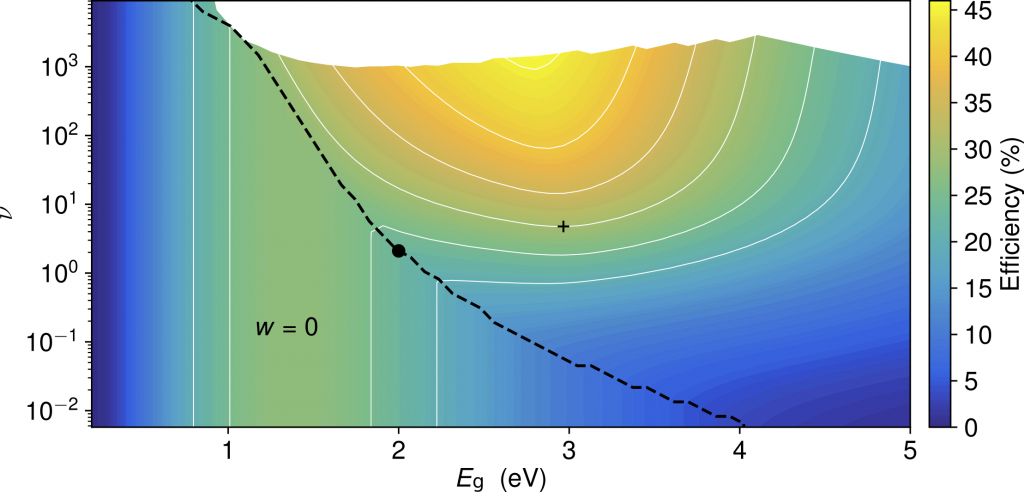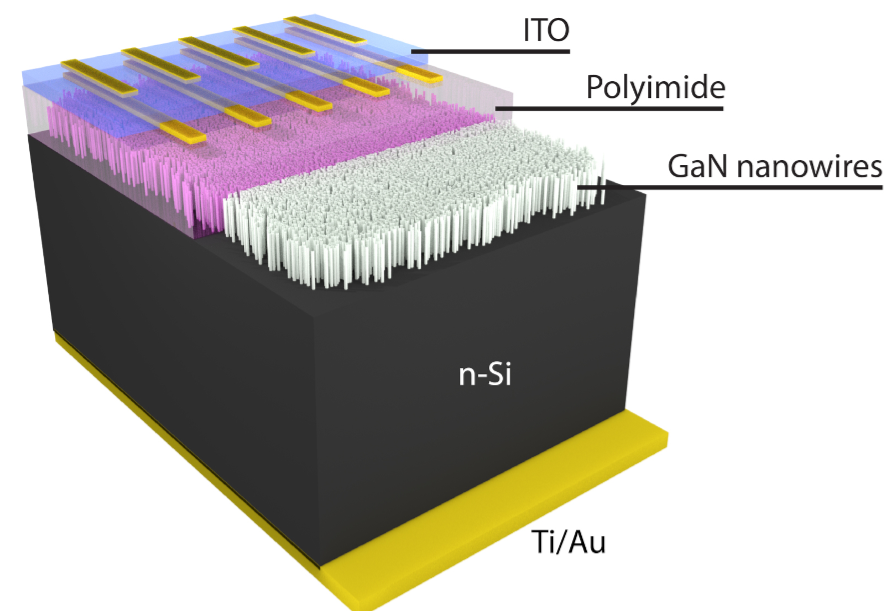I am seeking graduate students. If you are interested in theoretical research in advanced photovoltaics or probing quantum properties of energy transport using ultrafast spectroscopy, please contact me via email, providing your cv and a description of your interests. Please note that due to uOttawa tuition policies, under most circumstances I cannot accept international MSc students.
I am also seeking a postdoctoral fellow in the field of nonlinear spectroscopy. If you are interested in theoretical and computational research in the design and interpretation of high-order nonlinear spectroscopies, please send your cv and a description of your interests by email, along with the references mentioned in the advertisement.
Research in my group is focused on photovoltaics and nonlinear optical spectroscopy. My photovoltaic research includes solar cells, thermophotovoltaics, and monochromatic photonic power converters. We work closely with experimentalists with the goals to understand advanced photovoltaic systems and novel materials, improve the efficiency of converting light to electricity, and develop affordable sources of low-carbon electricity.
The University of New South Wales has posted video of me discussing some of my group’s work on intermediate band solar cells, from August 2018.
Photovoltaics
Intermediate band photovoltaics
With an intermediate band, two low-energy photons can promote an electron from the valence band to the conduction band. An ideal intermediate band photovoltaic, cartooned below, could have an efficiency of 63% with concentrated sunlight, higher than the 41% maximum without the intermediate band.

While it is easy for a theorist to posit the existence of intermediate band materials, there are nearly no naturally occurring materials that have intermediate bands. There are four major classes of intermediate band materials that have been developed: quantum dot systems, highly mismatched alloys, hyperdoped semiconductors, and organic molecules. None has yet shown high efficiency, and the fundamental question in the field is whether the promise of IBPV can be realized.
We work to understand, design, and optimize IB materials for IB solar cells.
Figure of Merit
We proposed a figure of merit for intermediate band solar cells that captures the tradeoffs between subgap light absorption (\(\alpha \)) and the electron/hole lifetimes (\(\tau\)). The product
\(\nu = \mu \tau \alpha^2 \frac{kT}{q}\)
characterizes the ability of an IB device to both absorb light and collect the carriers, where \(\mu\) is the carrier mobility, \(kT\) is the thermal energy, and \(q\) is the electric charge. If those parameters are measured for each IB material, it is possible to determine whether they have the potential to be effective IB devices.

Device modeling (Simudo)
Essentially all optoelectronic devices are simulated before manufacturing. Device simulation facilitates the interpretation of experimental studies as well as optimizing of designs. But standard device simulation tools do not allow treatment of IB materials. We have designed Simudo, a free and open source device simulator for semiconductor devices, including any number of intermediate bands. Simudo uses the finite-element method to solve the Poisson and drift-diffusion equations for carriers in multiple bands, where standard models are limited to two bands. It is available on github, and we are happy to help new users get started. Just send an email to Eduard or Jacob.
Since there has not previously been a distributed device model that can treat IB materials, we find that most studies done with Simudo are interesting and surprising. We are using it to explore the design rules, optimization, and experimental interpretation of idealized IBSCs as well as those made from quantum dots, highly mismatched alloys, and hyperdoped materials.
Plasmonics
Intermediate band solar cells rely on having a band of states entirely contained inside the semiconductor band gap. If the intermediate band can conduct, then it must also support plasmon excitations. We explore the plasmonic structure of intermediate band materials and how their properties are different from those of standard metallic and semiconducting materials.
Nanowire solar cells

Forests of nanowires can absorb light even better than planar slabs, allowing less material to be used. This savings is doubly convenient, since GaAs has a larger lattice constant than silicon, making it impossible to grow full planar layers directly on top of silicon without inducing large numbers of dislocations, which degrade device performance. Nanowires of GaAs and related alloys can be grown directly on silicon, since the sidewalls of the nanowire allow strain to relax without forming defects. The nanowire geometry can allow highly efficient tandem solar cells (GaAsP on silicon, for example) to be grown with high-quality material.
Since the best nanowire spacings for light absorption are only a few hundred nanometers, Maxwell’s equations must be solved to determine that absorption and where in the wire the absorption occurs — key factors for operation of solar cells. We have used integrated device modeling to improve the design of nanowire solar cells. We also updated the optoelectronic simulation software S4 [link] to give an improved algorithm for extracting E and B fields throughout the device. These improvements allow accurate and computationally inexpensive determination of optical absorption profiles, for use in full device models.
We work to improve the modeling and design of nanowire solar cells along with the LaPierre group at McMaster and also explore nanowires with embedded quantum dots for IBSCs, as shown in the figure above.
Monochromatic photovoltaics: photonic power converters
Photovoltaics can be used to convert any light to electricity, not just light from the sun. Monochromatic light, as from a laser or LED, can be converted to electricity, allowing wireless energy transfer (eg, to or between satellites) or energy transfer through fiberoptics. There is no thermodynamic limit on the efficiency of a monochromatic photovoltaic, at least in the limit of infinite incident optical intensity. We have built a detailed balance model that describes the achievable efficiencies and voltage outputs of multijunction photonic power converters and are working to design and improve devices at 1310 nm and 1550 nm operating wavelengths, in collaboration with SUNLAB, the Wasilewski group at Waterloo, and the AIIR-POWER consortium.
Near field thermophotovoltaics
Another non-solar application of photovoltaics is to convert waste heat — in power plants, factories, car exhaust — to electricity. The radiation from such hot sources has longer wavelength than sunlight, so different photovoltaic devices with smaller band gaps need to be designed in order to efficiently convert the light to electricity. We are working with the St-Gelais group and SUNLAB at uOttawa and the Rodriguez group at Princeton to design new thermophotovoltaics that take advantage of near-field heat transfer, which can allow much higher radiative heat transfer and thus power production than in far-field emission.
Nonlinear optical spectroscopy
Spectroscopy means shining light onto something in order to learn about it. In standard (linear) spectroscopy, the light shines onto the molecule in its unexcited state, and which wavelengths are absorbed gives information about how that molecule can be excited. Nonlinear spectroscopies involve shining multiple pulses of light, to see how the system responds.
Energy transfer in molecular systems is an essential part of photosynthesis, photochemistry, and organic photovoltaics. Excitations move between molecules on timescales ranging from femtoseconds to picoseconds. An array of nonlinear optical spectroscopies is used to understand these energy transfer processes, giving insight into biological function and how to design artificial light harvesters and devices. These spectroscopies use ultrashort pulses of light (often 10 fs in duration) to first excite the desired system and then, after a time delay, to probe how the system has evolved.
High-order spectroscopies
Working with the group of Tobias Brixner in Würzburg, we have developed and demonstrated techniques for separating the perturbative orders of response in transient absorption (TA) spectroscopy. Our first results were published in three papers in 2023 (Nature, JCP, JPCL) and we have proposed a new way to think about these high-order TA signals (JPCL). We are currently working to extend the method to other spectroscopies.
In transient absorption spectroscopy, we first use a pulse of light, called a pump, to excite the molecule. Then we wait a time T, after which the probe arrives. We measure how the absorption of the probe beam changes due to the pump. If the probe arrives a long time after the pump, the molecule will be back in its unexcited state, and the probe absorption looks just like the linear absorption. But if the probe arrives soon after the pump, the molecule can be in an excited state, and it will absorb light differently; some wavelengths more and some wavelengths less. We can learn about excitations in the molecule and how they evolve in time by watching these absorptions change with the delay time T.
The first step in a TA measurement is usually to make sure that you are only exciting the molecule once. But if the pump laser is too strong, some of the molecules in the sample get excited two (or three, or four, or …) times, and the TA spectrum becomes a mixture from all those different states of the molecule, which is generally hard to understand. So the energy in the pump laser is made weaker and weaker until the signal varies linearly with the pump energy. But a larger pump energy means the signal is stronger and the experiment can be performed faster. So there is a tradeoff.
We proved and demonstrated that experimenters can take TA spectra with multiple different pump energies and then add/subtract them according to an algorithm that we provide, giving
- Clean TA responses that do not have double, triple, quadruple, etc. excitation in them at all
- Separate signals from the higher-order responses (the ones with two, three, etc. excitations in them).
We used these higher-order responses to understand some really interesting features about the annihilation of excitons in squaraine copolymers, as well as in other systems.
UFSS
Extracting information from nonlinear spectroscopies generally requires having a model of the system under study, and then fitting the parameters of the model to best reproduce experimental spectra. That process — moving from a model system to a prediction of a spectrum — can be surprisingly complicated. We have developed the Ultrafast Spectroscopy Suite — a set of four tools that enable researchers to parametrize their model systems, describe their spectroscopy, and produce model spectra. UFSS is designed to treat arbitrary optical pulse shapes, including when multiple pulses hit the sample at the same time, effects that are often neglected. When the system sizes are not too large, our methods can be hundreds of times faster than standard so-called direct propagation methods. These tools are not only fast but also designed for ease of use, with a convenient Python interface. This speed and versatility enable robust fitting of experimental data and design of new spectroscopic methods.
We further design spectroscopic experiments to enable extraction of desired information, from electronic coherence to quantum process tomography. When one desires to know more about a particular molecular property, one can often design a novel spectroscopy — by choosing pulse polarizations, pulse sequences, or pulse durations — to focus sensitivity on the desired property. We work with experimental groups to implement such methods.
Open source software
Simudo — Drift-diffusion device modeling software. While releases are on github, if you are interested to develop or watch the development process, you will want to see the fossil repository, instead. Written in Python, using FEniCS.
Ultrafast Spectroscopy Suite — Highly efficient prediction of nonlinear optical spectroscopies for energy-transfer systems. Written in Python
S4 improvements — S4 (the Stanford Stratified Structure Solver) is a widely used implementation of Rigorous Coupled Wave Analysis for layered structures. We have modified the extraction algorithm for E and B fields to allow high accuracy without Gibbs phenomenon due to lateral interfaces between different materials. Written in C++ and Python.
We are happy to help new users get started with our tools. Feel free to send an email to jkrich@uottawa.ca or to the lead author of the tool.
Updated 2024